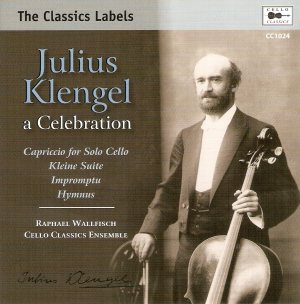 |
 |
|


alternatively
CD: MDT
AmazonUK
AmazonUS
|
Julius Klengel - A Celebration
Julius KLENGEL (1859-1933)
Capriccio on a theme of Schumann for unaccompanied cello (1905)
[16:23]
Three Pieces for two cellos and organ (pub.1931) [16:11]
Kleine Suite, for three cellos [17:30]
Impromptu for four cellos [5:25]
Hymnus for twelve cellos [5:24]
Recordings by Julius Klengel, transferred from 78 recordings:-
Johann Sebastian BACH (1685-1750)
Sarabande [3:13]
Giuseppe TARTINI
Adagio [2:55]
Bernhard COSSMANN
Tarantelle [2:21]
David POPPER
Mazurka [3:24]
 Raphael Wallfisch (cello) - Capriccio
Raphael Wallfisch (cello) - Capriccio
Sebastian Comberti and Sarah Butcher (cellos) with Martin Ennis
(organ) - Three Pieces
Sebastian Comberti, Joely Koos and Sarah Butcher (cellos) - Kleine
Suite
Sebastian Comberti, Julia Desbruslais, Ben Chappell and Sarah Butcher
(cellos) - Impromptu
Cello Classics Ensemble - Hymnus
rec. April 2009, St Silas, London , except Three Pieces, recorded
September 2010, Girton College Chapel, Cambridge and Capriccio,
recorded May 2011, St Silas, London
 CELLO CLASSICS CC1024 [72:47]
CELLO CLASSICS CC1024 [72:47]
|
|
|
Julius Klengel (1859-1933) was one of the most important figures
in the history of the cello. He studied composition in his native
Leipzig with Salomon Jadassohn (who taught Grieg and Delius)
and whose own music has been recorded, very successfully, of
late. Klengel made his debut at 17 whilst a member of the Leipzig
Gewandhaus, whose ranks he had joined two years earlier. His
pupils at the Leipzig Conservatoire included some of the most
prominent players of the twentieth century: Feuermann, Suggia,
Piatigorsky, Edmund Kurtz, Paul Grümmer and William Pleeth
amongst them. He composed quite widely, and was the recipient
of many dedications and gave many premieres. Reger was a particularly
good colleague but he was a good friend of Brahms, as well as
Taneyev amongst many others.
This celebratory disc intersperses some of Klengel’s own
78 discs between original compositions and adds up to a fine
portrait. His Capriccio was written in 1905 and dedicated
to his most flamboyant student, Guilhermina Suggia. It makes
appropriately strong demands whilst basing itself strongly on
the introduction of Schumann’s Op.121 Violin Sonata. There
then follow some testing variations, and serious investigations
of every aspect of left and right hand technique. No wonder
it used to be a competition favourite.
Three Pieces for two cellos and organ was published in
1931. There’s a definite sense of poignancy as the two
cellos entwine supported by the organ - and a strong element
of spiritual sensitivity too, as well as quiet charm. The Little
Suite is in five movements, Klengel ensuring the three cellist’s
parts are cleverly distributed and not tangled up. There’s
a coquettish Gavotte, a Borodin or maybe even Taneyev-like
Largo and a confident Fughette to end. He goes one better
in the Impromptu for four cellos, which opens as a hymnal
affair but then bursts into the Wedding March most unexpectedly
and most amusingly. The final piece is the poignant Hymnus,
for twelve cellos, dedicated to the memory of the conductor
Artur Nikisch at whose funeral it was played in 1922. It exemplifies
his gift for beautiful part writing and rich romanticism.
Klengel’s own playing can be heard in four works - his
portamenti are pervasive, often promoting pathos (as in the
Tartini Adagio), rhythm solid, technique powerful (try
the tricksy Crossmann Taranetlla) and reasonable tone.
I wish the examples had been dated with full discographic details
however. The Bach Sarabande is a fine performance and
I know was recorded in 1927.
Raphael Wallfisch takes on the finger and wrist crunching challenges
of the Capriccio on a theme of Schumann. His cellistic
and other colleagues named in the head note and those in the
twelve-strong Cello Classics Ensemble perform admirably and
have been well recorded. The booklet is attractive. Maybe it’s
time for some large-scale Klengel works to be recorded. How
about his Double Concerto for starters?
Jonathan Woolf
|
|

